This is an AI Free Zone! Text created by ChatGPT and other Large Language Models is spreading rapidly across the Internet. It's well-written, artificial, frequently inaccurate. If you find a mistake on Spaceweather.com, rest assured it was made by a real human being. | | |
GEOMAGNETIC STORM WATCH (G1): A magnetic filament erupted near the sun's southwestern limb on Aug. 23rd (movie). The debris might graze Earth's magnetic field on Aug. 27th, according to NOAA models. A glancing blow could spark G1-class geomagnetic storms with auroras around the Arctic Circle. Aurora alerts: SMS Text
HYPERBOLIC COMET UPDATE: Comet Nishimura (C/2023 P1) is falling toward the sun for a close encounter on Sept. 13th. Currently, it is just outside the orbit of Venus, and accelerating toward Mercury's orbit. Austrian astronomer Michael Jaeger photographed the hyperbolic comet on Aug. 24th and found that it has grown a 1-degree-long tail:
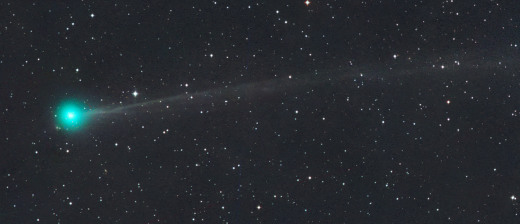
Since it was discovered in mid-August, Comet Nishimura has more than tripled in brightness--a sign that it is feeling the heat of the approaching sun. Its green head now shines like an 8th magnitude star. Friday morning, Aug. 25th, is a good time to observe it. Drawing a line through the brightest stars of Gemini (Castor and Pollux) leads directly to the comet in the morning predawn sky: finder chart.
Realtime Comet Photo Gallery
Free: Spaceweather.com Newsletter
DO SUNSPOTS MAKE CLOUDS ON NEPTUNE? A new paper in the research journal Icarus offers dramatic proof that solar activity can affect planetary weather. The big surprise: The planet is Neptune, 2.5 billion miles from the sun. Images taken by the Hubble Space Telescope over a period of 28 years show bright clouds forming in sync with the 11-year solar cycle:
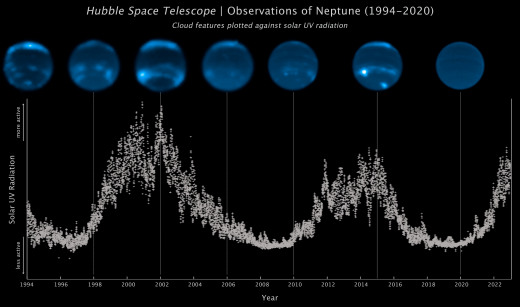
Above: Near-infrared images of clouds on Neptune compared to the 11-year solar cycle
The connection between Neptune and solar activity is surprising to planetary scientists because Neptune is our solar system's farthest major planet. It receives only 0.1% of the sunlight we get on Earth. Yet Neptune's cloudy weather seems to be driven by solar activity, and not the planet's four seasons, which each last approximately 40 years.
Other planets in our solar system don't behave this way. While clouds on Earth may be influenced by the solar cycle, the modulation is no more than a few percent; and even that small amount is controversial. Neptune's clouds, on the other hand, are bright, flamboyant and global. Their correlation with the solar cycle is obvious at a glance.
Chavez and her colleagues believe they have an explanation.
"Our findings support the theory that the sun's ultraviolet rays, when strong enough, may be triggering a photochemical reaction that ultimately leads to high-altitude clouds on Neptune," says Imke de Pater, emeritus professor of astronomy at UC Berkeley and a senior co-author of the study.
Their paper describes how UV rays from the sun (which are strongest when the sunspot number is high) penetrate Neptune's upper atmosphere and break apart molecules of methane gas. This sets off a chemical reaction yielding hydrocarbons (C𝑥H𝑦). If these hydrocarbons sink into the atmosphere, they could condense to form hazes and clouds.
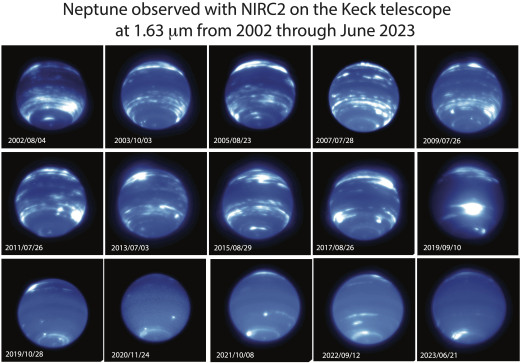
Above: 21 years of images from the Keck Observatory in Hawaii confirm Hubble's observations. [more]
Why doesn't this happen on every planet? "Neptune is unique," says de Pater. Unlike other planets in our solar system, Neptune has a lot of methane in its stratosphere. (How it gets there is a mystery, but that's another story.) Solar UV rays have little trouble reaching the gas and kick-starting cloud formation.
Based on the data so far, it seems to take about two years for Neptune's clouds to fully form once the solar cycle reaches its peak. Solar Cycle 25 is rising now with a peak expected in 2024. This means Neptune's cloudy season is about to begin. Stay tuned.
Realtime Space Weather Photo Gallery
Free: Spaceweather.com Newsletter
HUMOROUS "I LOVE YOU MORE" PENDANT: It's made of sterling silver and it will make you laugh: The "I Love You More" Space Pendant shows a cute money gazing at a golden banana inside a silver heart. The students of Earth to Sky Calculus thought it was hilarious, so on June 20th they flew it to the stratosphere:
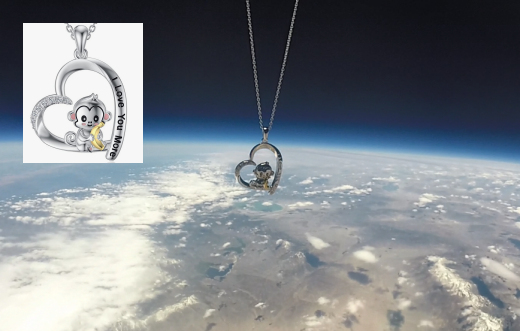
You can have it for $134.95. Engraved with the words, "I love you more," the pendant makes a great gift for romantic partners with a sense of humor. It comes with a greeting card showing the pendant in flight and telling the story of its journey to the stratosphere and back again.
Far Out Gifts: Earth to Sky Store
All sales support hands-on STEM education
Realtime Aurora Photo Gallery
Free: Spaceweather.com Newsletter
Every night, a network of
NASA all-sky cameras scans the skies above the United States for meteoritic fireballs. Automated software maintained by NASA's Meteoroid Environment Office calculates their orbits, velocity, penetration depth in Earth's atmosphere and many other characteristics. Daily results are presented here on Spaceweather.com.
On Aug 24, 2023, the network reported 23 fireballs.
(21 sporadics, 2 Northern Delta Aquariids)
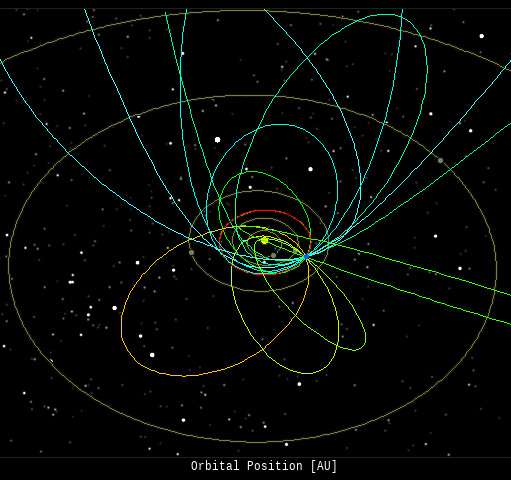
In this diagram of the inner solar system, all of the fireball orbits intersect at a single point--Earth. The orbits are color-coded by velocity, from slow (red) to fast (blue). [Larger image] [movies]
Potentially Hazardous Asteroids (
PHAs) are space rocks larger than approximately 100m that can come closer to Earth than 0.05 AU. None of the known PHAs is on a collision course with our planet, although astronomers are finding
new ones all the time.
On August 24, 2023 there were 2349 potentially hazardous asteroids.
 |
Recent & Upcoming Earth-asteroid encounters: | Asteroid | Date(UT) | Miss Distance | Velocity (km/s) | Diameter (m) |
| 2023 QP3 | 2023-Aug-19 | 4.1 LD | 10.9 | 11 |
| 2023 QE2 | 2023-Aug-19 | 1.1 LD | 12.4 | 10 |
| 2011 QJ21 | 2023-Aug-19 | 13 LD | 15.1 | 45 |
| 2023 QZ3 | 2023-Aug-19 | 17.5 LD | 7.2 | 46 |
| 2023 QS1 | 2023-Aug-19 | 0.3 LD | 15.7 | 7 |
| 2023 QR | 2023-Aug-20 | 0.5 LD | 20.9 | 5 |
| 2023 QE | 2023-Aug-21 | 8.7 LD | 6.5 | 12 |
| 2023 PM1 | 2023-Aug-21 | 8.2 LD | 18.6 | 68 |
| 2023 QB1 | 2023-Aug-21 | 1.8 LD | 11.3 | 6 |
| 2023 PM | 2023-Aug-22 | 9.5 LD | 7 | 56 |
| 2023 QZ | 2023-Aug-22 | 13.5 LD | 4.5 | 15 |
| 2023 QU1 | 2023-Aug-22 | 16.4 LD | 5.7 | 21 |
| 6037 | 2023-Aug-23 | 15.9 LD | 14.3 | 571 |
| 2023 QW | 2023-Aug-23 | 4.2 LD | 16.3 | 23 |
| 2023 QO | 2023-Aug-23 | 6.5 LD | 8.8 | 15 |
| 2023 QF | 2023-Aug-23 | 1.9 LD | 5.4 | 12 |
| 2023 QS2 | 2023-Aug-23 | 12.6 LD | 17.6 | 33 |
| 2023 QN2 | 2023-Aug-24 | 19.1 LD | 15.4 | 43 |
| 2023 QK2 | 2023-Aug-24 | 7.7 LD | 4.9 | 16 |
| 2023 QG4 | 2023-Aug-25 | 6.6 LD | 24 | 109 |
| 2023 QC2 | 2023-Aug-25 | 9.2 LD | 10.2 | 20 |
| 2023 QT1 | 2023-Aug-26 | 11.5 LD | 10.6 | 32 |
| 2007 RR17 | 2023-Aug-26 | 8.3 LD | 7.1 | 63 |
| 2023 QR1 | 2023-Aug-27 | 4.3 LD | 5 | 12 |
| 2023 QQ | 2023-Aug-27 | 10.7 LD | 10.1 | 26 |
| 2023 QD2 | 2023-Aug-29 | 3.3 LD | 7.8 | 15 |
| 2012 PZ17 | 2023-Aug-30 | 16.8 LD | 3.6 | 16 |
| 2023 QH | 2023-Aug-31 | 12 LD | 15.9 | 64 |
| 2023 QB2 | 2023-Sep-01 | 8.1 LD | 7.2 | 21 |
| 2023 QZ1 | 2023-Sep-01 | 18.2 LD | 18.6 | 51 |
| 2023 QU | 2023-Sep-01 | 13.6 LD | 9.8 | 34 |
| 2017 BY32 | 2023-Sep-02 | 16.4 LD | 3.5 | 19 |
| 2023 QG | 2023-Sep-03 | 11.6 LD | 13.7 | 74 |
| 2023 QH1 | 2023-Sep-03 | 13.1 LD | 6.4 | 24 |
| 2021 JA5 | 2023-Sep-06 | 13.3 LD | 10.9 | 19 |
| 2020 GE | 2023-Sep-08 | 14.9 LD | 1.4 | 8 |
| 2020 RT2 | 2023-Sep-12 | 11 LD | 10 | 8 |
| 2016 LY48 | 2023-Sep-16 | 5 LD | 10.8 | 99 |
| 2010 TE | 2023-Sep-16 | 6.8 LD | 6 | 22 |
| 523598 | 2023-Sep-20 | 19.8 LD | 25 | 239 |
| 2019 SF6 | 2023-Sep-26 | 16.7 LD | 8.6 | 20 |
| 2013 TG6 | 2023-Sep-28 | 3.6 LD | 4.1 | 17 |
| 2009 UG | 2023-Sep-30 | 6.1 LD | 9 | 78 |
| 349507 | 2023-Oct-03 | 16.5 LD | 21 | 696 |
| 2022 FX1 | 2023-Oct-04 | 20 LD | 9.9 | 25 |
| 2022 TD | 2023-Oct-07 | 8.9 LD | 9.4 | 10 |
| 2018 ER1 | 2023-Oct-08 | 12.5 LD | 5.3 | 27 |
| 2022 UX1 | 2023-Oct-11 | 3.1 LD | 8.6 | 9 |
| 2015 KW120 | 2023-Oct-12 | 18.2 LD | 13 | 22 |
| 2021 NT14 | 2023-Oct-13 | 18.6 LD | 8.6 | 254 |
| 2011 GA | 2023-Oct-15 | 6.8 LD | 16.6 | 230 |
| 2007 SQ6 | 2023-Oct-15 | 19.4 LD | 6.5 | 130 |
| 2019 UZ3 | 2023-Oct-16 | 9.6 LD | 8.3 | 14 |
| 1998 HH49 | 2023-Oct-17 | 3.1 LD | 14.8 | 193 |
| 2022 UO10 | 2023-Oct-19 | 7.8 LD | 9.8 | 16 |
| 2020 UR | 2023-Oct-20 | 5.8 LD | 12.9 | 9 |
Notes: LD means "Lunar Distance." 1 LD = 384,401 km, the distance between Earth and the Moon. 1 LD also equals 0.00256 AU. | | Cosmic Rays in the Atmosphere |
SPACE WEATHER BALLOON DATA: Almost once a week, Spaceweather.com and the students of Earth to Sky Calculus fly space weather balloons to the stratosphere over California. These balloons are equipped with sensors that detect secondary cosmic rays, a form of radiation from space that can penetrate all the way down to Earth's surface. Our monitoring program has been underway without interruption for 7 years, resulting in a unique dataset of in situ atmospheric measurements.
Latest results (July 2022): Atmospheric radiation is decreasing in 2022. Our latest measurements in July 2022 registered a 6-year low:
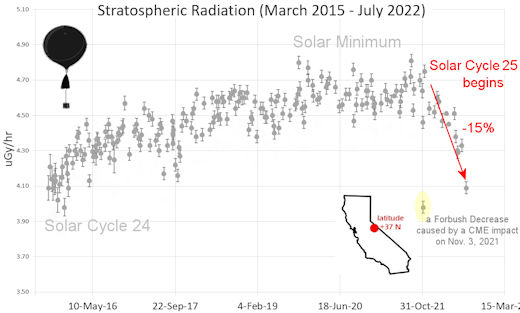
What's going on? Ironically, the radiation drop is caused by increasing solar activity. Solar Cycle 25 has roared to life faster than forecasters expected. The sun's strengthening and increasingly tangled magnetic field repels cosmic rays from deep space. In addition, solar coronal mass ejections (CMEs) sweep aside cosmic rays, causing sharp reductions called "Forbush Decreases." The two effects blend together to bring daily radiation levels down.
.Who cares? Cosmic rays are a surprisingly "down to Earth" form of space weather. They can alter the chemistry of the atmosphere, trigger lightning, and penetrate commercial airplanes. According to a study from the Harvard T.H. Chan school of public health, crews of aircraft have higher rates of cancer than the general population. The researchers listed cosmic rays, irregular sleep habits, and chemical contaminants as leading risk factors. A number of controversial studies (#1, #2, #3, #4) go even further, linking cosmic rays with cardiac arrhythmias and sudden cardiac death.
Technical notes: The radiation sensors onboard our helium balloons detect X-rays and gamma-rays in the energy range 10 keV to 20 MeV. These energies span the range of medical X-ray machines and airport security scanners.
Data points in the graph labeled "Stratospheric Radiation" correspond to the peak of the Regener-Pfotzer maximum, which lies about 67,000 feet above central California. When cosmic rays crash into Earth's atmosphere, they produce a spray of secondary particles that is most intense at the entrance to the stratosphere. Physicists Eric Regener and Georg Pfotzer discovered the maximum using balloons in the 1930s and it is what we are measuring today.
| | The official U.S. government space weather bureau |
| | The first place to look for information about sundogs, pillars, rainbows and related phenomena. |
| | Researchers call it a "Hubble for the sun." SDO is the most advanced solar observatory ever. |
| | 3D views of the sun from NASA's Solar and Terrestrial Relations Observatory |
| | Realtime and archival images of the Sun from SOHO. |
| | information about sunspots based on the latest NOAA/USAF Active Region Summary |
| | current counts of failed and deployed Starlink satellites from Jonathan's Space Page |
| | Authoritative predictions of space junk and satellite re-entries |
| | from the NOAA Space Environment Center |
| | fun to read, but should be taken with a grain of salt! Forecasts looking ahead more than a few days are often wrong. |
| | from the NOAA Space Environment Center |
| | the underlying science of space weather |
 | Getting YouTube comments is essential if you want to beat the algorithm! That’s why you need to buy YouTube comments from RealSocialz.com because they offer real USA comments you can customize. |
 | When looking for casinos to play online when the weather is bad, you can try casino online trucchi for Italian games. If you are not from Finland you can try the Swedish page Svenska casino online to find suitable games, check out svenskacasinoonline.net. Always check your local laws before playing with real money. |
 | BestCSGOGambling is the best site for everything related to CSGO gambling on the web |
| | These links help Spaceweather.com stay online. Thank you to our supporters! |
| | | | | | |

